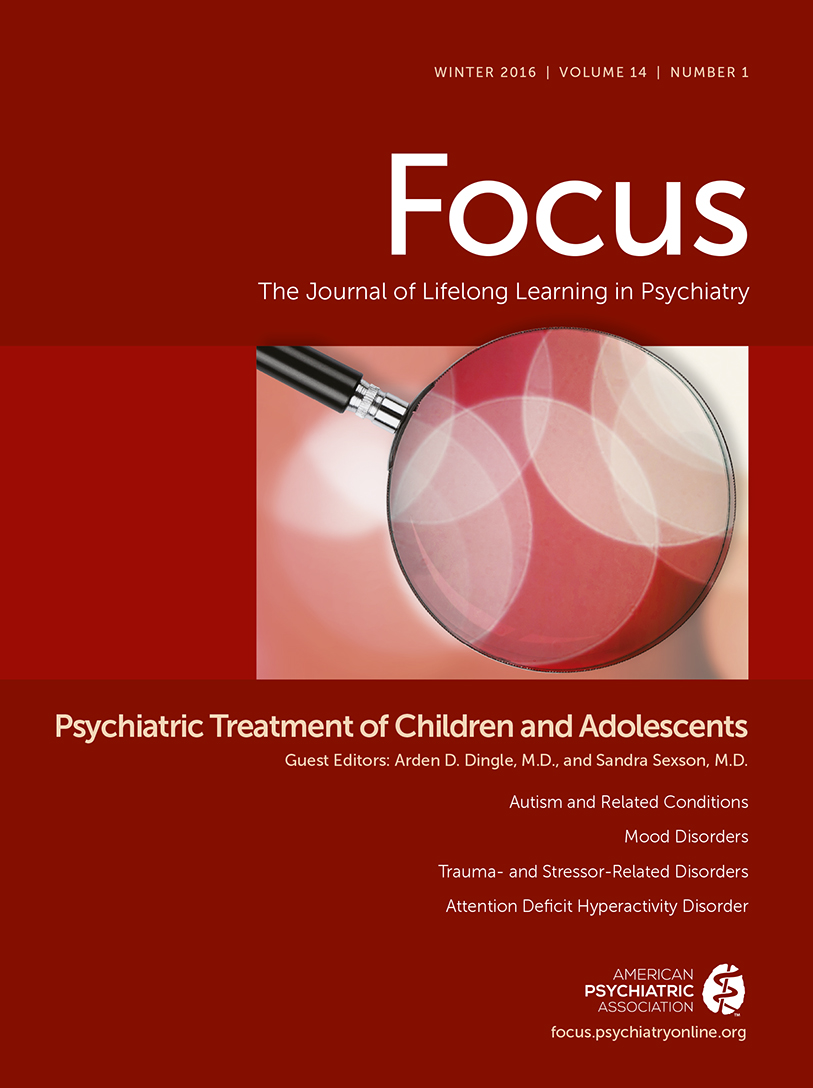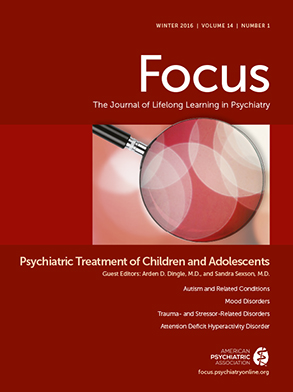Applying Developmental Principles
Appreciating the spectrum of abilities and behaviors that are considered to be developmentally typical is an essential skill for a practicing psychiatrist. Distinguishing between developmental phenomena and psychiatric illness can be challenging, especially in children. Children and adolescents often exhibit behavior that is difficult to manage, immature developmentally in certain areas, and a mismatch with environmental expectations. However, they may still be within the range of typical development. Whether a child or adolescent with emotional or behavioral problems has a psychiatric disorder or is developing typically but with certain characteristics (e.g., persistent temper tantrums) may be unclear. Psychiatric assessments should result in coherent, integrated overviews that describe individuals and their current lives, personal histories, and circumstances; detail psychopathology, including the relevant biological, psychological, and social factors that are producing, perpetuating, and mitigating symptoms; address factors related to resilience; and describe current and possible levels of functioning. Children and adolescents require particular attention to environmental factors, circumstances, and relationships because of their developmental and legal status vulnerabilities.
Development is generally defined as the emergence of physical and mental structures, functions, and related behaviors that result from interactions between the individual, mind, and environment. There are a range of theories explaining growth and development; they assume normality (range of behavior exhibited by most healthy individuals, considered socially and culturally appropriate for a given age and developmental level). For the most part, these models are based on observations of individuals (variable numbers), both clinical and nonclinical populations, mostly from Westernized cultures. Most identify stages that occur in an orderly progression, build on the previous ones, and become more complex and complicated with increasing age. These developmental theories describe maximum expectable capabilities at each stage. It is clear that culture, socioeconomic factors, or other environmental issues often influence a number of manifestations of developmental stages and tasks; these factors are not addressed in most theories. Development tends to be highly individual and may not consistently follow the stage or task models for any given person. Individuals develop at their own rate and may progress at different rates in different areas of development. Development rarely occurs at a constant rate; there are usually periods of apparent stagnation alternating with rapid growth, especially at younger ages.
Two common developmental theories that are utilized in clinical medicine are Piaget’s theory on cognitive development and Erikson’s model of psychosocial stages across the lifespan. Although development typically does not occur in stages as discretely and sequentially as described in these models, their basic concepts have been validated and supported by research and clinical practice.
Piaget believed that knowledge of world must be discovered and structured by a child’s own activities. His four-stage model is based on the assumption that certain factors influence cognitive behavior: maturation of the nervous system, experience, social transmission of knowledge (i.e., teaching), and importance of equilibration (tendency for mental growth to progress toward increasingly complex and stable organization levels). Erikson developed a model to explain psychosocial development, based on the premise that a major goal of development is the development of a coherent and stable personal identity. This theory covers the lifespan, with eight stages organized by developmental tasks and challenges. Criticisms have been that these stages are overly proscriptive for the wide variability in child development and that they disregard the subtleties of an individual's life and are too uniform to explain the marked differences in individual lives.
Case Note
This child appears to be at the concrete operations stage in Piaget’s model; his achievement at school is appropriate for his age, and he is able to plan and organize his play on the basis of personal experiences. He appears to be in Erikson’s industry phase versus the inferiority phase. The child is appropriately engaged with peers, although he appears to be an individual who prefers having a few friends rather than many. He is using suitable activities and methods to work on developing mastery of skills and knowledge.
When evaluating an individual, several other aspects of development can be helpful to consider. Emotionally, individuals are expected to acquire the capacity to recognize and use emotions appropriately, be emotionally responsive rather than reactive, acquire appropriate and effective coping strategies, and use this emotional repertoire to manage the inherent anxiety and stress of being human. Certain developmental capabilities are related to successful emotional and social development: temperament, attachment, and theory of mind. Having certain types of attachment and temperament or incomplete theory-of-mind capabilities has been shown to increase the risks of certain psychopathology later in life, although other genetic and environmental factors also have significant impact. Temperament describes individual differences in behavioral style when interacting with others and the environment. Although temperament has been studied primarily with infants, it seems to be an inherited quality that appears to be stable and contribute to later personality and interpersonal characteristics. Temperament classifications are based on the dimensions of activity level, typical mood, and reactions to new stimuli (intensity, adaptability, positivity). An important concept is the idea of goodness of fit: the compatibility between an infant’s capabilities and temperament and environmental demands and expectations. Attachment is a concept describing an individual’s ability to form discriminating and specific relationships and emotional/psychological connection with others. This capability forms within the context of the infant’s interactions with primary caretakers and then is generalized to other individuals to form relationships of varying degrees of strength. Attachment appears to provide a foundation for many aspects of development/learning and functions to provide sense of security, help with regulation of affect and arousal, support expression of feelings and communication, model behavior and activities, and serve as a base for exploration of the environment. Attachment can be categorized as secure or insecure, based on a child’s behavior when separated and reunited with the primary caretaker. Theory of mind refers to the capability to see and understand events and ideas from another person’s perspective. It requires cognitive, social, and attentional skills and is closely associated individual self-differentiation and awareness of others. This capability is foundational for multiple aspects of development.
Case Note
This child seems to be acquiring better emotional stability and is learning to manage temperamental traits (being slow to warm up and having difficulty with new and stimulating situations). He appears to be securely attached, connected to his parents, and able to utilize them for comfort and support. In addition, the parents appear to have been able to modulate and modify their responses so that they have been available for the child.
The biological development and function of the central nervous system (CNS), although difficult to tie to the acquisition of specific developmental abilities, is also a key consideration. Although the CNS is regulated by genes, CNS development and function are significantly influenced by internal and external environmental factors. There appear to be critical periods of increased activity in certain parts of the CNS, as well as times of selective vulnerability. Both synaptic formation and pruning are essential processes. The brain appears to be more plastic than previously thought, with the capability to compensate within limits for damage by formation of alternative pathways.
By school age (5–12 years of age), children have acquired Piaget’s level of concrete operations, meaning that they have a logical, reality-based approach to thinking and can understand and share the perspectives of others on the basis of their own experiences. According to Erikson, this stage (industry versus inferiority) is characterized by learning that hard work leads to achievement and by identifying with a peer group. In general, children in this age group have better inhibition and control of impulses, and they are more able to postpone action and gratification. The primary focus of this phase is the mastery of skills and activities. Children tend to identify with their caretakers and important adults. Their conscience becomes established with behavior more based on internalized values. The use of obsessive-compulsive behavior and sublimination to manage anxiety is common with frequent fears about body integrity, competence, and appearance. Children who are successfully managing the developmental tasks of this age are better at identifying and dealing with their emotions, having strategies to manage their intrinsic responses to environmental stresses, and being more able to use internalized attributes to cope with issues with less need for parental interventions and physical proximity.
Reviewing this case, the child appears to be developmentally appropriate. He is achieving at grade level, completing expected responsibilities, developing and maintaining close relationships, and working on becoming competent. The child has activities that he enjoys and does consistently. His psychiatric issues appear to be adequately treated and do not appear to be interfering with his ability to function and develop. At this age, children have difficulty being motivated by factors outside of their personal experiences and generally are more interested and engaged by immediate rewarding activities. Imaginary play is one approach to working on mastery; children often use this forum to practice skills and interactions relevant to the tasks and expectations of daily life and demonstrate significant initiative around these types of activities. In addition, this child is doing what is expected at home and at school.
Case Note
Although the child may have some difficulties managing environmental stresses related to temperament, these appear manageable. At this point, the child appears to be functioning adequately within a supportive environment. However, it probably would be helpful to consider interventions to help the child with areas that are challenging, such as adjusting to change and participating in team activities. Being developmentally appropriate should not preclude children from getting help with issues that they struggle with.

